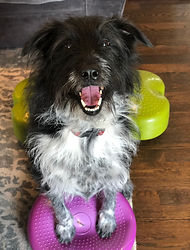
title.Training efficiently
date. 2017
for. shelter volunteers, dog parents, agility dogs, Family Manners
How to train smarter!


1. Optimal training should happen in short sessions - ideally, no more than 5 minutes at a time. More time than that will likely strain the dog’s attention span and counteract your efforts.
2. Think positive! Always look for something to reward. Better to start a session right off the bat by noticing and rewarding something that the dog is doing right (example : a dog that typically jumps up to greet you can be rewarded for having 4 on the floor before you begin) rather than waiting for the dog to be “wrong” and starting your time together with a time-out.

"Silver" modeling the latest in girlie Gentle Leaders.



Teaching a Chin Hold for veterinary / handling purposes during puppy class
3. Think carefully about what you are rewarding. Dogs learn from the immediate consequences of their behavior. A behavior that is reinforced will increase in frequency. An example : Your dog sits without being asked when you approach her. You reward that behavior by starting a training session with the dog. The behavior of Sitting resulted in something the dog wanted, so sitting will increase in frequency. Another example : your puppy tugs at his leash to play with it, and the handler tugs back in order to get him to release the leash. However, the puppy was rewarded by the handler playing tug - thus, the behavior of tugging on the leash has been rewarded and will happen again.


4. Dogs are amoral creatures - they don’t “know better” and are incapable of guilt and remorse. If the dog you’re working with has a bad habit, think about how the dog is being reinforced for that bad habit. Change the consequences so that the bad habit is no longer reinforced. Example : the dog barks at you, and you talk back to her: “What is it! No! No barking!” If she keeps barking after you do that, then you have rewarded her behavior of barking. The dog continues to bark because that behavior results in something that the dog finds rewarding: attention (even if it is scolding) from you. A more effective way to stop her from barking would be to provide a time out (turn around and ignore the dog completely until the barking stops). When barking no longer works for the dog, barking will stop.
Coco, my fabulous Pomeranian friend.
5. What does your dog love most as a reward? Food? Attention? Playing tug? Going for a walk? Use that thing as a reward for good behaviors. This is why I will nearly always wait for a Sit or 4 on the Floor before beginning training. You control the access to everything the dog wants - so, use those favorite things as rewards for good behaviors that you are teaching the dog.

Zola, my training buddy at the Mt Vernon Animal Shelter.
“It must be worthwhile for the animal to play the trainer's silly little game.
I know, I know, to us (the trainer) the "game" may be important business, and we usually think of it that way. That might suggest to us that the animal should be concerned about it, or impressed with its importance, too.
Well, with few exceptions, most of what we do with dogs has most probably little to do with how "dogs of old" (that is in the evolutionary history of dogs) earned their livings - that is, chasing things and killing and eating. So, to put things into some sort of perspective for our students, I often refer to humans and their "silly little games," and it is up to the human to make it (the game) so worthwhile that the dog will play, and play enthusiastically.” - Bob Bailey
